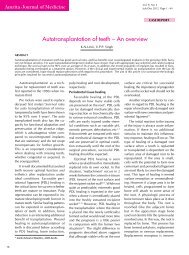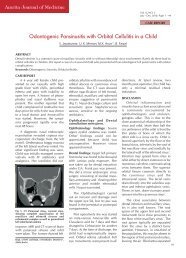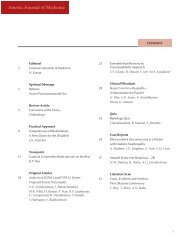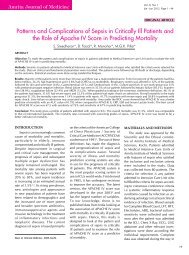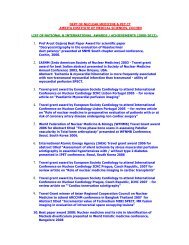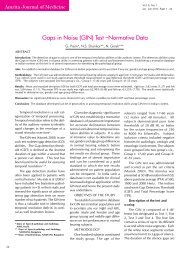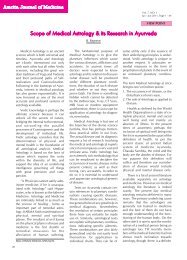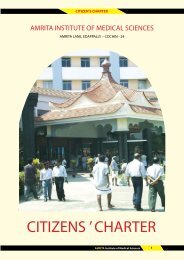Journal of Medicine Vol 2 - Amrita Institute of Medical Sciences and ...
Journal of Medicine Vol 2 - Amrita Institute of Medical Sciences and ...
Journal of Medicine Vol 2 - Amrita Institute of Medical Sciences and ...
Create successful ePaper yourself
Turn your PDF publications into a flip-book with our unique Google optimized e-Paper software.
<strong>Amrita</strong> <strong>Journal</strong> <strong>of</strong> <strong>Medicine</strong><br />
Living Donor Liver Transplantation in Acute Hepatic Failure – viable option in Indian context<br />
King’s College criteria for transplantation in acute liver failure:<br />
Non – acetaminophen cause<br />
INR >6.7<br />
Or any three <strong>of</strong><br />
Unfavorable cause (eg. Drug induced, non A<br />
non B hepatitis, Halothane hepatitis)<br />
Age 40 years<br />
Acute/Subacute presentation<br />
Bilirubin level >300mmol/L<br />
Acetaminophen<br />
Arterial pH 300mmol/L<br />
INR > 6.5<br />
INR > 3.5<br />
cipient received 8 units <strong>of</strong> packed cells <strong>and</strong> 9 units <strong>of</strong><br />
plasma. The donor hepatectomy was accomplished without<br />
the need for red cell transfusion. The donor was<br />
extubated immediately postoperatively while the recipient<br />
was extubated the next day.<br />
Initial immunosuppression was with injectable methyl<br />
prednisolone alone. Oral steroids, Tacrolimus <strong>and</strong><br />
Mycophenolate M<strong>of</strong>etil were started on the third postoperative<br />
day. Tacrolimus dose was adjusted to maintain<br />
serum trough levels between 5 <strong>and</strong> 15ng/ml. The convalescence<br />
was rather smooth <strong>and</strong> she was discharged on<br />
24 th postoperative day. At follow up in 3 rd month, she is<br />
back to near normal life. The donor is back to his routine<br />
activities <strong>of</strong> daily living.<br />
DISCUSSION<br />
AHF is a clinical syndrome that results from sudden<br />
loss <strong>of</strong> hepatic parenchymal <strong>and</strong> metabolic functions <strong>and</strong><br />
manifests as coagulopathy <strong>and</strong> encephalopathy. The<br />
causes differ in various parts <strong>of</strong> the world. In U.K <strong>and</strong><br />
USA 5 acetaminophen <strong>and</strong> idiosyncratic drug reactions are<br />
the most commonly identified etiologic agents while in<br />
Japan <strong>and</strong> India acute hepatitis B is the leading cause <strong>of</strong><br />
AHF 6 . It is known that spontaneous survival rates from<br />
AHF due to acetaminophen toxicity <strong>and</strong> Hepatitis A are<br />
high 4 , while the rates for other viral hepatitis <strong>and</strong> idiosyncratic<br />
drug reactions are low.<br />
AHF constitutes a medical emergency associated with<br />
a high mortality due to the development <strong>of</strong> cerebral<br />
edema, coagulopathy <strong>and</strong> bleeding complications. The<br />
role <strong>of</strong> LT in AHF has been established beyond doubt.<br />
The essential challenge is identifying the crucial timing<br />
for transplantation. This involves maintaining the fine<br />
balance between possible reversibility <strong>of</strong> the condition<br />
through hepatic regeneration versus development <strong>of</strong> complications,<br />
which may either contraindicate transplant or<br />
render the condition irretrievable despite a transplant! A<br />
useful tool to assess whether a patient is likely to become<br />
irreversible is the Kings college criteria 7 , for early<br />
identification <strong>of</strong> indices with a poor prognosis.<br />
Traditional cadaveric graft if available <strong>and</strong> in a good<br />
condition, is considered ideal because patients with AHF<br />
have a huge metabolic dem<strong>and</strong>. However, even in countries<br />
with an established cadaveric organ-sharing program,<br />
a suitable donor may not be easily available in the emergency<br />
setting <strong>of</strong> AHF. Over the last few years, the use <strong>of</strong><br />
living donor liver transplantation (LDLT) has been evaluated<br />
<strong>and</strong> the benefits in the setting <strong>of</strong> AHF are<br />
well-established 8 . The advantages are that graft function<br />
is usually excellent as cold ischaemia time can be kept<br />
to a minimum <strong>and</strong> the procedure can be completed on<br />
an emergency basis before the patient’s condition deteriorates<br />
irreversibly. The potential disadvantage is possible<br />
inadequacy <strong>of</strong> available liver volume; hence the safer left<br />
liver grafts (Fig.1) have given way to the functionally larger<br />
right liver, albeit at the cost <strong>of</strong> significantly higher donor<br />
morbidity <strong>and</strong> mortality 9 .<br />
Donor related complications can be kept to a minimum<br />
by careful preoperative estimation <strong>of</strong> the donor liver<br />
volume <strong>and</strong> a careful delineation <strong>of</strong> the vascular <strong>and</strong> biliary<br />
anatomy <strong>of</strong> the two lobes <strong>of</strong> the liver. The size <strong>of</strong> the<br />
graft required by the recipient is estimated by the graft to<br />
recipient weight ratio (GRWR), which is the weight <strong>of</strong><br />
the graft divided by the weight <strong>of</strong> the recipient multiplied<br />
by 100 (ideal GRWR = 1), <strong>and</strong> balanced against<br />
the 40% <strong>of</strong> the original liver volume that has to be retained<br />
in the donor. CT volumetry is invaluable in this<br />
regard 10 . It is imperative while planning the parenchymal<br />
transection to ensure adequate vascular inflow <strong>and</strong> outflow<br />
<strong>and</strong> biliary drainage <strong>of</strong> all the segments in both the<br />
lobes <strong>of</strong> the liver to avoid functional parenchymal loss in<br />
either the donor or recipient. The information obtained<br />
34



